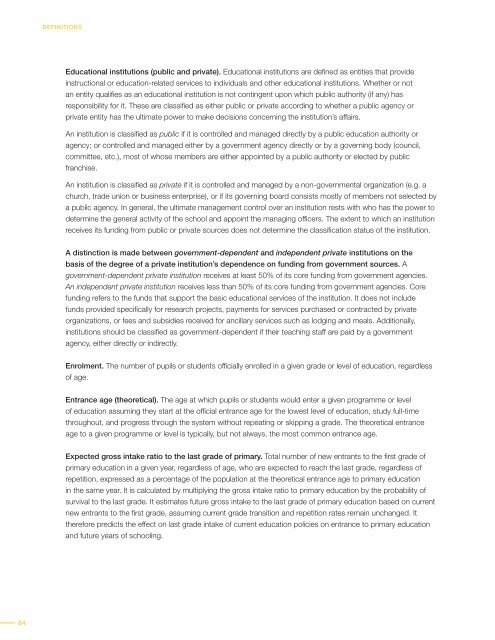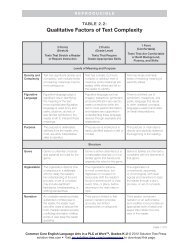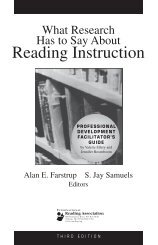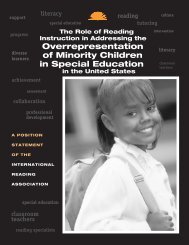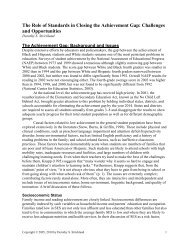Global Education Digest 2012 - International Reading Association
Global Education Digest 2012 - International Reading Association
Global Education Digest 2012 - International Reading Association
You also want an ePaper? Increase the reach of your titles
YUMPU automatically turns print PDFs into web optimized ePapers that Google loves.
DEFINITIONS<br />
<strong>Education</strong>al institutions (public and private). <strong>Education</strong>al institutions are defined as entities that provide<br />
instructional or education-related services to individuals and other educational institutions. Whether or not<br />
an entity qualifies as an educational institution is not contingent upon which public authority (if any) has<br />
responsibility for it. These are classified as either public or private according to whether a public agency or<br />
private entity has the ultimate power to make decisions concerning the institution’s affairs.<br />
An institution is classified as public if it is controlled and managed directly by a public education authority or<br />
agency; or controlled and managed either by a government agency directly or by a governing body (council,<br />
committee, etc.), most of whose members are either appointed by a public authority or elected by public<br />
franchise.<br />
An institution is classified as private if it is controlled and managed by a non-governmental organization (e.g. a<br />
church, trade union or business enterprise), or if its governing board consists mostly of members not selected by<br />
a public agency. In general, the ultimate management control over an institution rests with who has the power to<br />
determine the general activity of the school and appoint the managing officers. The extent to which an institution<br />
receives its funding from public or private sources does not determine the classification status of the institution.<br />
A distinction is made between government-dependent and independent private institutions on the<br />
basis of the degree of a private institution’s dependence on funding from government sources. A<br />
government-dependent private institution receives at least 50% of its core funding from government agencies.<br />
An independent private institution receives less than 50% of its core funding from government agencies. Core<br />
funding refers to the funds that support the basic educational services of the institution. It does not include<br />
funds provided specifically for research projects, payments for services purchased or contracted by private<br />
organizations, or fees and subsidies received for ancillary services such as lodging and meals. Additionally,<br />
institutions should be classified as government-dependent if their teaching staff are paid by a government<br />
agency, either directly or indirectly.<br />
Enrolment. The number of pupils or students officially enrolled in a given grade or level of education, regardless<br />
of age.<br />
Entrance age (theoretical). The age at which pupils or students would enter a given programme or level<br />
of education assuming they start at the official entrance age for the lowest level of education, study full-time<br />
throughout, and progress through the system without repeating or skipping a grade. The theoretical entrance<br />
age to a given programme or level is typically, but not always, the most common entrance age.<br />
Expected gross intake ratio to the last grade of primary. Total number of new entrants to the first grade of<br />
primary education in a given year, regardless of age, who are expected to reach the last grade, regardless of<br />
repetition, expressed as a percentage of the population at the theoretical entrance age to primary education<br />
in the same year. It is calculated by multiplying the gross intake ratio to primary education by the probability of<br />
survival to the last grade. It estimates future gross intake to the last grade of primary education based on current<br />
new entrants to the first grade, assuming current grade transition and repetition rates remain unchanged. It<br />
therefore predicts the effect on last grade intake of current education policies on entrance to primary education<br />
and future years of schooling.<br />
64


